Abstract
As the climate continues to change, coastal areas and people who live there face increasing risks from erosion and wave damage. The impacts of climate change are made worse by declines in natural oyster reefs, which historically provided some natural protection. However, oysters can be restored for the specific purposes of protecting shorelines. Intended for coastal property owners and local governments that must make decisions about protecting shorelines in the face of a changing climate, this publication describes the practicality and cost-effectiveness of using oysters in this way.
Introduction
Scientists call oysters estuarine "ecosystem engineers"—organisms that create, modify, maintain, and otherwise alter habitat for themselves or other organisms. Oysters serve this function in coastal systems because they build large reefs that provide ecologically valuable habitat (Jones et al. 1997). Worldwide, oyster populations have declined by an estimated 90% from what they were a century ago due to over-harvesting, loss of quality habitat area, and disease (Beck et al. 2011). Florida oysters have also declined.For example, Naples Bay has experienced an 80% lossin oyster reefs since 1950, while oyster reef habitat has decreased by 99% in southeast Florida(zuErmgassen et al. 2012: Schmid et al. 2006) and by66% in the Big Bend region of northwest Florida (Seavey et al. 2011).
These decreases in oyster populations have led to increases in oyster restoration intended to sustain or supplement remaining populations and recover lost ecosystem services that oysters provide. Ecosystem services are the free benefits that functioning ecosystems provide to humans. Oyster reefs provide many ecosystem services (Grabowski et al. 2012). The oysters themselves filter water as they feed, removing algae, and increasing water clarity. In fact, a single oyster can filter anywhere from 21gallons of water to 540 gallons of water per day (Ehrich & Harris 2015). Oysters also help remove and store nitrogen that, at excess levels, can contribute to harmful algal blooms that can cause fish kills. The reefs that oysters create provide physical habitat with lots of small spaces used as refuges or foraging places by finfish, other invertebrates, and birds. This means oysters indirectly support fishing and birding activities. Oyster reefs can also retain freshwater near coastlines to sustain estuarine conditions (Kaplan et al. 2016) and reduce wave energy to decrease shoreline erosion (Rodriguez et al. 2014; Waldbusser et al. 2011). Preventing the effects of shoreline erosion is a precious ecosystem service for coastal residents concerned about their properties and homes. This specific service has given rise to using oysters in green infrastructure projects known as "living shorelines." Living shorelines are the addition or restoration of a naturally occurring habitat that provides ecological benefits, specifically shoreline protection (Scyphers et al. 2011; Piazza et al. 2005).
This publication describes why oyster reefs may be a particularly efficient way to protect shorelines from erosion caused by boat wakes or storms and identifies the costs and benefits of using oysters in this way. Homeowners, engineering firms, and restoration practitioners can use this information to aid individuals considering shoreline stabilization methods. Management agencies can use this information to conduct surveys to gauge homeowners' interest in living shorelines in their communities.
Shoreline Armoring
Coastal human populations along the Gulf of Mexico are expected to continue to grow, as seen in Mobile Bay (Figure 1). People understandably want to protect their coastal property from the impacts of shoreline erosion, leading to an increase in shoreline armoring via artificial structures like seawalls and bulkheads (Figure 1). A more natural option for protecting coastal property is using oyster reefs within living shorelines. Living shorelines built with oysters are created by the placement of semi-permanent structure in the nearshore and intertidal zones. Small oysters (called spat) settle on the structure and grow to re-establish oyster reefs (Hernandez et al. 2018).
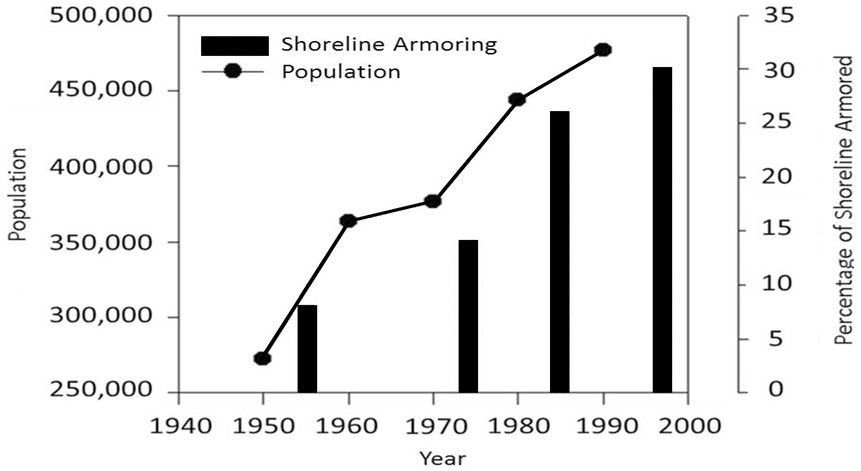
Credit: Scyphers et al. 2011
The case for oysters
Shoreline armoring is the use of artificial structures to prevent the erosion of shorelines. In the absence of natural shoreline protection, like oyster reefs, many people armor their shorelines with seawalls and bulkheads made of wood, concrete, or metal—sometimes called "hard" armoring. Manmade, engineered structures used to armor shorelines are typically installed in a vertical manner (like a wall), but placing piles of rocks or concrete, known as "rip-rap," is also a common approach. Hard armoring structures that are vertical are especially problematic because scouring results at the base can eventually undermine the structure and damage habitat. These structures also reduce the intertidal zone's spatial area that is important to many estuarine plants and animals (Scyphers et al. 2011). Hard shoreline armoring approaches are costly for landowners, both to install and to maintain (Scyphers et al. 2011). Despite the cost, hard shoreline armoring like this does not always provide quality long-term protection against flooding from sea-level rise and erosion (Borsje et al. 2011). These artificial structures are "static" and cannot change their shape on their own in response to rising sea levels or retreating shorelines (Borsje et al. 2011). These artificial, static structures cannot heal themselves in the way living shorelines, like oyster reefs, can regrow following damage. Thus, shoreline armoring projects such as bulkheads and seawalls have long-term maintenance costs associated with them, reducing the return on investment.
Cost of Protection
Artificial structures like bulkheads, jetties, and breakwaters can be used to limit waves, but these are expensive to build, costing more than $1M per hectare (Meyer et al. 1997). The cost to build these structures may exceed the cost of oyster reef restoration, which averages around $2,260 per hectare in the United States (Henderson and O'Neil 2003)—though the costs can vary greatly (Hernandez et al. 2018).
Table 1. Estimated costs of shoreline armoring per linear meter of shoreline (in 2020 dollars). The cost for oyster reefs is estimated based on maximum restoration costs per hectare, assuming that 5m wide shorelines is required to protect 1m of shoreline (Grabowski et al. 2011). Costs of bulkhead, sills, and groins are from Allison 2001. Note: Values for sills or groins depend on the type of stone.
Often homeowners have a set budget for construction projects, such as living shorelines or other shoreline stabilization methods. If a homeowner has a $10,000 budget, we estimate that an oyster reef would protect 68m of shoreline protection. At the same time, this amount would only support 14 linear meters of shoreline protection with a bulkhead (Table 2).
Table 2. Amount of shoreline a homeowner could protect with $10,000 investment using cost per linear meter from Table 1. Oyster reefs were converted to area based on the assumption that the reef would be 5m wide (Grabowski et al. 2012).
In addition to benefiting from oyster reefs’ lower initial cost compared to typical armoring structures, property owners that restore oyster reefs to protect their shorelines have a greater expected return on investment. One hectare of oyster reef provides at most $85,988 in annual shoreline stabilization services over 20 years as the restored reef matures. In most cases, one hectare of oyster reef provides the average return of $860 per year in shoreline stabilization value. The minimum shoreline stabilization value (not total net value) a 1-hectare oyster reef would provide would be $0 if the reef fails to recruit oysters and build structure or is degraded through harvest (Grabowski et al. 2012). The proximity of restoration to the property also contributes to the ecosystem service value to the property owner as it relates to beach erosion and wave attenuation. Including benefits such as increased finfish and crustacean populations, increased habitat quality for the adjacent area, increased biodiversity, and nitrogen removal, a hectare of oyster reef provides $117,257 worth of services annually (Table 2). Given the costs to restore a reef, the waterfront property owner could begin to see a return on their investment, in terms of total services, in 2–14 years (Grabowski et al. 2012; Hernandez et al. 2018). Providing an economic justification for living shorelines' environmental benefits may help homeowners with decisions regarding shoreline armoring choices.
Table 3. Total annual value of ecosystem services provided by pristine restored oyster reefs in 2020 dollars per hectare per year, as Grabowksi et al. (2012) described. Oyster reef habitat refers to the values specified for oysters (e.g., for recreational or commercial harvesting). In contrast, habitat quality refers to the value of oysters for broader habitats within the estuary (e.g., maintaining salinity regimes, reducing turbidity, and depositing nutrients that benefit other habitats, seagrasses, and other aquatic vegetation).
Ecological benefits of using oysters to stabilize shorelines
Finding more natural, rather than artificial solutions to coastal erosion and shoreline stabilization can be extremely cost-effective while also providing positive ecological impact on the surrounding ecosystem. To build an oyster reef, rock or shell are typically held in place with wire baskets, or plastic mesh or simply spread along the benthos in low wave energy areas. Oyster castles, interlocking concrete blocks, oyster balls, and other structures like reef prisms are just a few of the kinds of installations that may also be used as hard substrate placed back into the environment to mimic oyster reefs (Figure 2).
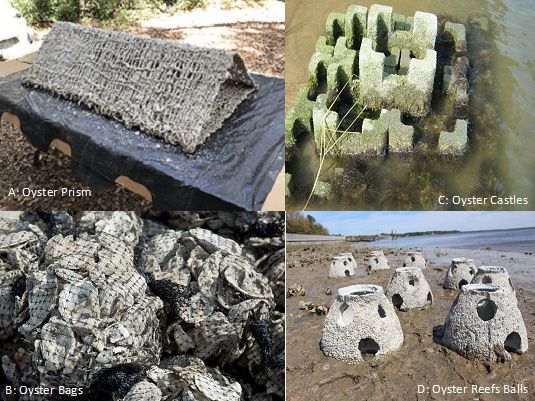
Credit: A: Oyster Prism: J. Dacey B: Oyster Bags: J. Dacey, C: Oyster Castles: VIMS, D: Oyster Reef Balls: J. Dacey
These structures give oyster spat a place to settle and grow. If there is not an abundance of wild oyster spat, people sometimes "seed" the structure by releasing live oyster spat obtained from local hatcheries to supplement wild oyster deficiencies. However, there are rules regulating moving spat from one place to another in Florida, and permits from FDACS and/or FWC must be obtained.
There are several reasons why oyster reefs provide a good solution for shoreline erosion that may be more ecologically friendly than other alternatives. Oyster reefs reduce wave height and absorb energy to combat the effects of waves and limit shoreline erosion (Borsje et al. 2011). Oyster reefs are also a viable option to include in living shoreline projects because, in a natural setting, oyster reefs shield salt marshes from waves by absorbing energy from incoming water, reducing marsh loss and retreat by stabilizing sediments (Scyphers et al. 2011). Similarly, oysters can benefit adjacent habitats such as seagrass beds (Booth and Heck 2009). Established oyster living shorelines can also continue to grow and adapt to changing conditions like rising seas (NRC 2007). The vertical growth rate of unharvested oyster reefs can outpace sea-level rise (Ridge et al. 2015). Vertical growth is vital because healthy, restored oyster reefs may function as a living, growing barrier to erosion that increases with water level. Typical artificial shoreline armoring cannot do this and instead usually needs to be replaced over time with taller structures (Scyphers et al. 2011). These traits can allow oyster reefs to be as or more effective, require less maintenance, and be more cost-efficient than artificial structures—in many (but not all) cases. But in almost all cases, oyster reefs would be expected to be better than no structure. For example, in Louisiana, against low, intermediate, and high wave energy levels, oyster reefs showed less shoreline movement over a 3-month period than mud shorelines without oyster reefs (La Peyre et al. 2015). This illustrates how the presence of oyster reefs is better for protection against beach erosion than no structure.
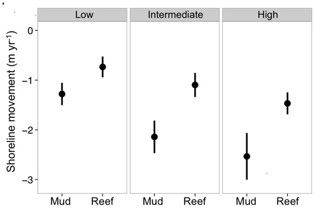
Credit: La Peyre et al. 2015
The vertical structure of oyster reefs makes them more efficient when compared to other bivalves in reducing wave energy. In a study of reef-building bivalves, researchers tested different types of bivalves' ability to reduce wave height in an artificial channel called a flume (Borsje et al. 2011). That study compared the wave energy reduction between an empty flume and one containing oysters or mussels. Oysters performed the best out of the three treatments in terms of reducing wave energy, assessed by the change in wave height.
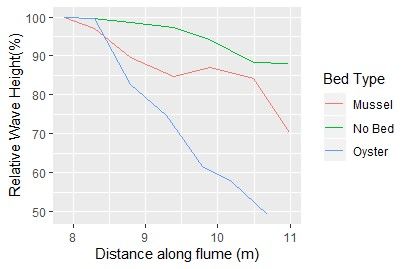
Credit: Modified from Borsje et al. 2011
Recent innovations in technology have improved our ability to identify sites that would benefit from oyster reef restoration and experience reduced shoreline erosion (La Peyre et al. 2015). Researchers created an oyster reef habitat suitability index for Breton Sound, Louisiana. The index identified which sites would have the greatest shoreline erosion impacts and sustain oyster populations. The best sites for oyster reef restoration were identified where the green points meet the dark blue areas (Figure 4). This method can help select optimal sites for restoration to protect against erosion. Figures like these can be reproduced using river discharge and ecological information (e.g., oyster predator density) data from potential restoration sites. This site identification method helps property owners determine if their coastal properties are viable sites for both oyster reef restoration and erosion prevention.
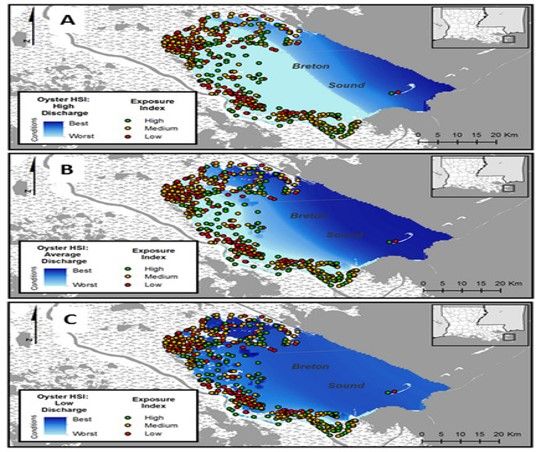
Credit: La Peyre et al. 2015
There are several reasons why oyster reefs might not be appropriate in all locations, including the supply of spat, wave energy, and water depth of subtidal areas. Using location-specific data on land type, marsh or seagrass presence, bathymetry, and water quality can help overcome these issues. In fact, growing number of public tools can help homeowners identify if their property would meet the criteria for a living shoreline project. For example, there is a living shoreline suitability model for residents of Cedar Key, Florida, and other similar projects have been completed throughout Florida and elsewhere—many of which have been derived from models produced by the living shoreline design guidance project at the Virginia Institute of Marine Sciences.
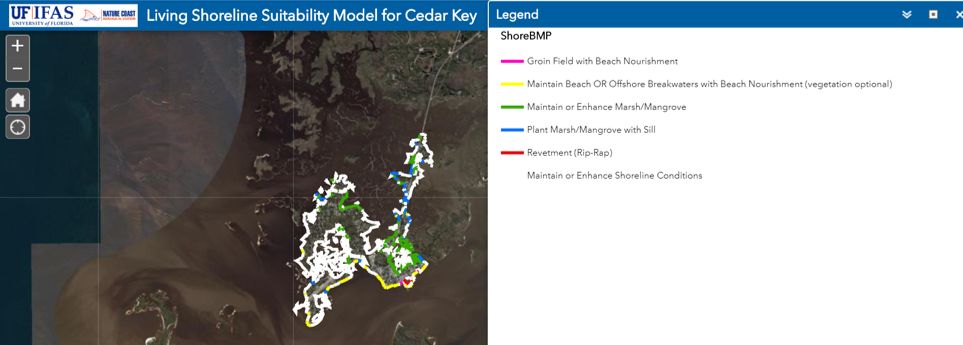
Credit: UF IFAS, NCBS
Conclusion
Overall, oyster reefs can play a major role in preventing shoreline erosion and may enhance coastal resiliency to sea-level rise in addition to providing environmental benefits. Sea-level rise and climate change will affect the 76.5% of Floridians that are coastal residents, living in counties directly adjacent to the Atlantic Ocean and the Gulf of Mexico (NOAA 2020). Projections predict that sea level will rise between 26 and 88 cm by 2100. Floridians will face increased vulnerability to storm surge inundation as well as shoreline and dune loss. Coastal property owners may want to consider investing in oyster shoreline protection as an alternative to bulkheads or other human-made infrastructure. One hectare of oyster reef returns on average $860 per year in shoreline protection benefits and a maximum of value of $85,988 over 20 years (Grabowski et al. 2012). In total, protecting a shoreline with oysters can provide at least $13,571 per hectare per year of environmental benefits with the average value being $23,274. Therefore, homeowners should consider installing oyster living shorelines as an investment in erosion protection and ecosystem services. For more information on the permitting process for installing a living shoreline see: https://edis.ifas.ufl.edu/sg187.
References
Allison, S. G. 2001. Analysis of Stream Bank Protectors on Rabbit Creek. University of South Alabama. (30 July 2012; www.usouthal.edu/geography/fearn/480page/01Allison/Allison.htm)
Beck, M. W., R. D. Brumbaugh, L. Airoldi, A. Carranza, L. D. Coen, C. Crawford, and H. S. Lenihan. 2011. “Oyster Reefs at Risk and Recommendations for Conservation, Restoration, and Management.” Bioscience 61 (2): 107–116.
Booth, D. M., and K. L. Heck Jr. 2009. “Effects of the American Oyster Crassostrea virginica on Growth Rates of the Seagrass Halodule wrightii.” Marine Ecology Progress Series 389:117–126.
Borsje, B. W., B. K. van Wesenbeeck, F. Dekker, P. Paalvast, T. J. Bouma, M. M. van Katwijk, and M. B. de Vries. 2011. “How Ecological Engineering Can Serve in Coastal Protection.” Ecological Engineering 37 (2): 113–122.
Ehrich, M. K., and L. A. Harris. 2015. “A Review of Existing Eastern Oyster Filtration Rate Models.” Ecological Modelling 297:201–212.
Ermgassen, P. S. E. Z., M. D. Spalding, B. Blake, L. D. Coen, B. Dumbauld, S. Geiger, and R. Brumbaugh. 2012. “Historical Ecology with Real Numbers: Past and Present Extent and Biomass of an Imperilled Estuarine Habitat.” Proceedings of the Royal Society B: Biological Sciences 279 (1742): 3393–3400. doi: 10.1098/rspb.2012.0313
Grabowski, J., R. D. Brumbaugh, R. F. Conrad, A. G. Keeler, J. J. Opaluch, C. H. Peterson, M. F. Piehler, S. P. Powers, and A. R. Smyth. 2012. “Economic Valuation of Ecosystem Services Provided by Oyster Reefs” BioScience 62 (10): 1 900–909. https://doi.org/10.1525/bio.2012.62.10.10
Henderson, J., and L. J. O'Neil. 2003. “Economic Values Associated with Construction of Oyster Reefs by the Corps of Engineers.” US Army Engineer Waterways Experiment Station, Engineer and Research Development Center. Technical Note no. ERDC TN-EMRRP-ER-01.
Hernandez, A., R. D. Brumbaugh, P. Frederick, R. Grizzle, M. W. Luckenbach, C. H. Peterson, and C. Angelini. 2018. “Restoring the Eastern Oyster: How much progress has been made in 53 years?” Frontiers in Ecology and the Environment 16 (8): 463– 471, doi:10.1002/fee.1935
Jones, C., J. H. Lawton, and M. Shachak.1997. “Positive and Negative Effects of Organisms as Physical Ecosystem Engineers.” Ecology 78 (7): 1946–1957.
Kaplan, D. A., M. Olabarrieta, P. Frederick, and A. Valle-Levinson. 2016. Freshwater Detention by Oyster Reefs: Quantifying a Keystone Ecosystem Service.” PloS one 11(12).
2015. Assessing Shoreline Exposure and Oyster Habitat Suitability Maximizes Potential Success for Sustainable Shoreline Protection Using Restored Oyster Reefs.” PeerJ 3:1317 https://doi.org/10.7717/peerj.1317
Meyer, D. L., E. C. Townsend, and G. W. Thayer. 1997. “Stabilization and Erosion Control Value of Oyster Cultch for Intertidal Marsh.” Restoration Ecology 5:93–99. doi:10.1046/j.1526-100X.1997.09710.x
National Oceanic and Atmospheric Administration 2020. Data accessed from: https://coast.noaa.gov/states/florida.html April 2020.
NRC. 2007 “Mitigating Shore Erosion along Sheltered Coasts.” Council NR, ed. Washington, DC: National Academies Press. 174 p.
Piazza, B. P., P. D. Banks, and M. K. La Peyre. 2005. “The Potential for Created Oyster Shell Reefs as a Sustainable Shoreline Protection Strategy in Louisiana.” Restoration Ecology 13:499–506.
Ridge, J. T., A. B. Rodriguez, F. J. Fodrie, N. L. Lindquist, M. C. Brodeur, S. E. Coleman, J. H. Grabowski, and E. Theuerkauf. 2015. “Maximizing Oyster-Reef Growth Supports Green Infrastructure with Accelerating Sea-Level Rise.” Scientific Reports 5:1–8.
Rodriguez, A., F. J. Fodrie, J. T. Ridge, N. L. Lindquist, E. J. Theuerkauf, S. E. Coleman, J. H. Grabowski et al. 2014. “Oyster Reefs Can Outpace Sea-Level Rise.” Nature Climate Change 4:493–497 doi:10.1038/nclimate2216
Schmid, J. R., K. Worley, D. S. Addison, A. R. Zimmerman, and A. V. Eaton. 2006. “Naples Bay Past and Present: A Chronology of Disturbance to an Estuary.” Technical Report to the City of Naples, funded by the South Florida Water Management District. p. 58.
Scyphers, S. B., S. P. Powers, K. L. Heck Jr, and D. Byron, 2011. “Oyster Reefs as Natural Breakwaters Mitigate Shoreline Loss and Facilitate Fisheries.” PloS one 6 (8), p.e22396.
Seavey, J. R., W. E. Pine III, P. Frederick, L. Sturmer, and M. Berrigan. 2011. “Decadal Changes in Oyster Reefs in the Big Bend of Florida's Gulf Coast.” Ecosphere 2: 114–14
Waldbusser, G. G., E. P. Voigt, H. Bergschneider, M. A. Green, and R. I. Newell. 2011. “Biocalcification in the Eastern Oyster (Crassostrea virginica) in Relation to Long-term Trends in Chesapeake Bay pH.” Estuaries and Coasts. 34:221–231 doi:10.1007/s12237-010-9307-0